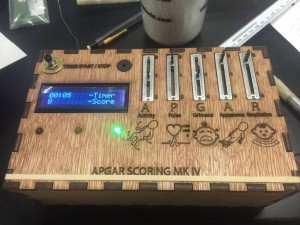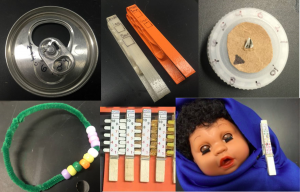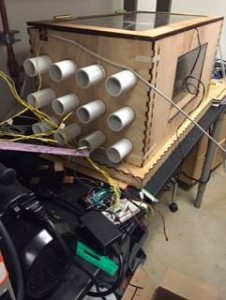It’s been a while since I last blogged, and a lot has happened since then.
First, for all intents and purposes, Harrison, Hanna, James and I have wrapped up the APGAR project. Our final prototypes will be traveled to Malawi on Wednesday with Dr. Wettergreen. They include some marking methods on clothespins as well as other clips and recording devices that can be made out of everyday items including water bottles, soda cans, and cardboard. We also have an electronic device that facilitates calculation of the APGAR score and also reminds midwives when to take the score. Going through the process of wiring, coding and then housing the electrical components gave me a great appreciation for the work that goes into developing devices – and we didn’t even get to a PCB stage! Also, I can’t leave this out, two weeks ago we spoke to a neonatologist at Texas Children’s Hospital about APGAR scoring both in Malawi (were he has visited) and in the U.S. It was a very insightful visit AND Harrison, Hanna, and I witnessed the miracle of birth. It was epic/crazy/kinda scary.


Last week, we also began working on IncuBaby. A group of seniors developed a low-cost incubator for their senior design project this past year. We are working with Rice360 associates Bailey and Mary-Kate to make some design improvements. For the most part, we have been working on ventilation for the device. We all exhale CO2 when we breathe and babies are no exception. With the closed compartment of the incubator, it is easy for CO2 to build up – to 1.7% with the incubator on and 4.0% with it off. We have been learning about and testing different ventilation strategies to keep the CO2 content down to 0.5%. Because it is cheaper and simpler, we have been focusing more on passive ventilation – holes that can help with air circulation. We have tried a number of different strategies and are close to settling on a placement for the vents. Testing consists of hour and a half long tests during which one must record the CO2 content and sometimes temperature. As of this point, we have been pretty successful in keeping the %CO2 down so we are now focusing more on what ventilation scheme will allow the temperature to stay up.

It’s great how much progress we have made in the past few weeks, and as the internship comes to an end, I am looking forward to seeing where each of the projects ends up.
In other news, we are trying to plan a zoo trip for this weekend!
Until next week,
Whitney